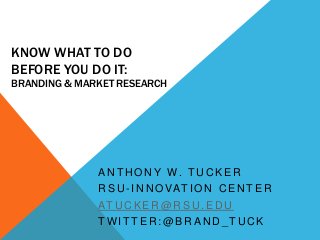
Branding Your Small Business
- 1. KNOW WHAT TO DO BEFORE YOU DO IT: BRANDING & MARKET RESEARCH A N T H O N Y W. T U C K E R R S U - I N N O VAT I O N C E N T E R AT U C K E R @ R S U . E D U TWITTER:@BRAND_TUCK
- 2. KEY PARTS TO BUILDING A SUCCESSFUL BRAND Know Your Market Develop a Situational Analysis Live the Brand Develop a Brand that is
- 3. KNOW WHAT AND WHO IS IN THE MARKET Analyzing the market starts with developing a situational analysis of what the market you plan to enter looks like. This includes the three c’s of situational analysis: Competitors Customers Company
- 4. SITUATIONAL ANALYSIS: COMPANY Basic Information on Your Company • What product or service do you offer? • Where do you sell your product? • What need is your product or service trying to fulfill in the market? • How is your product or service different from what is currently on the market? • Family owned versus corporation
- 5. SITUATIONAL ANALYSIS: CUSTOMERS Who is your ideal customer? Who are your competitors targeting? • Analyze your competitor’s marketing messages to know who they are targeting • Think profit size per market segment of customers-ROI • Analyze your potential customers by tangibles • Geographic Location • Demographics • Lifestyle • Values Sought From Product or Service
- 6. SITUATIONAL ANALYSIS: COMPETITORS Know who is there before assuming your going to be the only kid on the block. • Direct and indirect competitors • Analyze SIC codes if possible to generate list of competitors • Example of Hobby Lobby versus Walmart • Leverage resources available to analyze competitors and their messages • Google • Social Media • Market Research Programs • Libraries • RSU Innovation Center • NTC
- 8. BUILD YOUR BRAND-LIVE THE BRAND The worn out expression that a brand is more than a logo still retains its merit! Five Essential Parts to a Brand Visual Authenticity Voice Brand Attitude Physical
- 9. BUILD YOUR BRAND: VISUAL Remember the dis on logos a minute ago well not so fast your company’s image involving your company’s word mark, symbol, and colors are very important in consistent branding. Don’t deviate from the brand standards on all touch points with your customers. Make it easy for them to receive, store, and retrieve your brand’s visual. Evoke a feeling with your visual logo that is consistent with what you brand represents. Don’t go off on a tangent in a design that doesn’t match the feelings of emotion that you want to evoke. Analyze the market to understand the visuals from direct and indirect competitors. Is there a standard in the industry to comply with?
- 10. BUILD YOUR BRAND: VOICE Know your audience and speak in a manner that is consistent with your brand and relates with the audience. Messages can be altered to become relevant to each market segment if value of why to buy product or service differs. Analyze each direct and indirect competitor’s messages and analyze how to differentiate your message from their message.
- 11. BUILD YOUR BRAND: PHYSICAL Branding includes the five senses when speaking on physical identity of a brand rather product or service. Every bit of the experience with the brand must be consistent. Example: Unique Corn Maze Shape • Taste • Smell • Feel • Look • Sound
- 12. BRAND IDENTITY: ATTITUDE What does your brand represents both internally and externally. Be consistent with this messaging and be authentic with your commitments. Internal Company’s culture Work ethics External Commitment to the saving the environment Example: Decrease use of pesticides in farming in the state of Oklahoma
- 13. BUILD THE BRAND: AUTHENTICITY One of the best ways to “authenticate” your brand is to live it. Living your brand means trying to become the brand you say you are, by acting accordingly and maybe even by taking powerful actions that let the character of the company shine through. Don’t just talk the talk actually walk the walk. If your value message is fixated around the idea that your product or service offers the most innovative features on the market then don’t disappoint. Example: Higher Quality-Higher Price
- 14. LEVERAGE YOUR RESOURCES: SPREAD THE BRAND Leverage your resources to increase target audience’s exposure to the brand that is consistent. Build that top of mind awareness that is necessary to achieve specific goals. However don’t waste time on somebody that is not your target audience. Earn media coverage for being different. Not always paid placement. Creativity not always dollars.
- 15. KNOW WHAT TO DO BEFORE YOU DO IT Before you launch your business or expand your current business to achieve specific measurable goals ensure that you know what your spreading before you go to spread it.
- 16. FOR MORE HELP WITH YOUR BUSINESS VISIT RSUinnovation.com Facebook.com/RSUinnovationCenter Twitter: @RSUinnovation atucker@RSU.edu SCAN FOR MORE INFO
